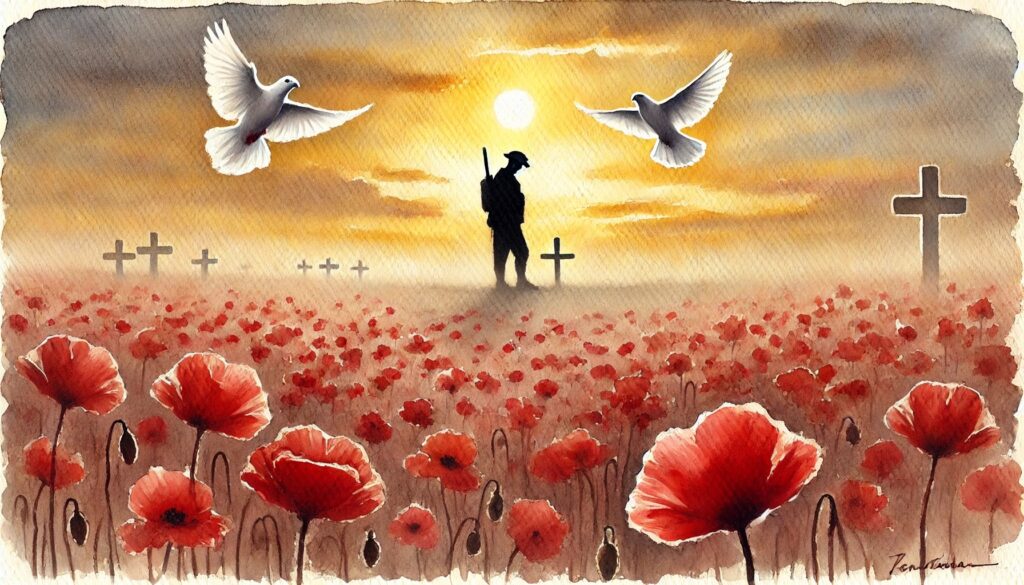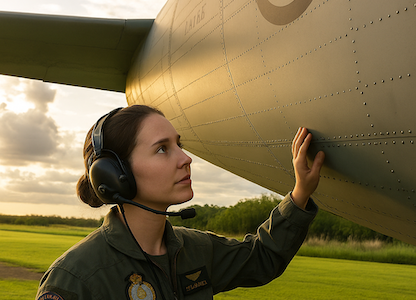Every year, on 11 November, Australia pauses to honour the courage, sacrifice, and legacy of its military personnel. Remembrance Day is more than a historical observance—it is a solemn tribute to the men and women who served and died in wars, conflicts, and peacekeeping missions.
At 11am, a nation stands still for a minute’s silence, reflecting on the price of war and the pursuit of peace. It is a day etched into the national conscience, marked by red poppies, commemorative services, and an enduring promise: “Lest We Forget.”
Key takeaways
- Remembrance Day is held annually on 11 November to honour Australian service members who died in wars, conflicts, and peacekeeping missions, with a national minute’s silence observed at 11am.
- It originated as Armistice Day after World War I and was renamed in 1946 to include all fallen Australian service members across various conflicts.
- Symbolic traditions like wearing red poppies, reciting The Ode, and playing The Last Post help Australians reflect on the cost of war and honour the fallen.
- Commemorative services take place nationwide at schools, workplaces, and war memorials, offering communities a chance to gather, reflect, and pay tribute.
- Remembrance Day encourages ongoing education and support, reminding younger generations of the sacrifices made and reinforcing the importance of peace, unity, and national memory.
Historical Origins
The End of World War I – 11 November 1918
At the 11th hour of the 11th day of the 11th month, the relentless gunfire on the Western Front finally ceased. After more than four years of brutal conflict, World War I officially ended with the signing of the Armistice. The moment was one of relief, grief, and deep reflection—a defining point in history that would forever be associated with remembrance.
The Birth of Armistice Day
In the immediate aftermath of World War I, nations sought a way to honour the immense loss of life. In 1919, the first Armistice Day was observed, dedicated solely to those who perished in the Great War. It was a day to mourn, to reflect, and to ensure that the sacrifices made were never forgotten.
From Armistice Day to Remembrance Day
As the world witnessed further devastation in World War II, it became clear that remembrance needed to go beyond those lost in the Great War. In 1946, Australia officially renamed Armistice Day to Remembrance Day, broadening its scope to honour all Australian service members who had died in wars and conflicts.
Since then, Remembrance Day has remained a central part of Australia’s commemorative tradition, helping each generation remember the cost of war and the lasting importance of peace.
Traditions and Observances
Moment of Silence (11am)
One of the most profound traditions of Remembrance Day is the minute’s silence observed at 11am — a moment when the entire nation pauses to reflect on the sacrifices of Australian service members. This solemn act was first proposed by Australian journalist Edward Honey in 1919 and later formalised by King George V.
For 60 silent seconds, Australians across busy city streets and quiet country towns pause together to honour those who lost their lives in war. It’s a shared moment that reflects the weight of service and sacrifice.
The Symbolism of the Red Poppy
The red poppy has become an enduring emblem of remembrance and sacrifice, inspired by the poem In Flanders Fields by Lieutenant Colonel John McCrae. The fields of the Western Front were left scarred by war, but amidst the devastation, poppies bloomed—an eerie yet poignant symbol of life persisting through tragedy.
In Australia, wearing a poppy on Remembrance Day serves as a tribute to fallen soldiers. Many also lay poppies at war memorials, reinforcing a personal and collective commitment to remembering those who served.
Commemorative Services
Across Australia, Remembrance Day ceremonies are held at war memorials, schools, workplaces, and public spaces. These services include:
- The playing of "The Last Post"
- The recitation of “The Ode”
- Wreath-laying and prayers.
These acts of remembrance help younger Australians reflect on the sacrifices that shaped the country they live in today.
The Unknown Soldier Tribute (1993)
A defining moment in Australia’s remembrance history was the entombment of the Unknown Australian Soldier at the Australian War Memorial in Canberra on 11 November 1993.
This soldier, whose identity remains unknown, represents all Australian service members who died in war without a known grave. His tomb serves as a symbol of collective sacrifice, reminding Australians that behind every statistic is a life, a name, a story.
The Significance of Remembrance Day for Australians
A Solemn Reminder of the Human Cost of War
Remembrance Day is more than a historical event—it is a day of reflection, gratitude, and recognition of the immense human cost of war. It acknowledges those who fought and died, but also those who returned home forever changed by conflict.
The tragedy of war does not fade with time, and Remembrance Day ensures that Australians never forget the price of peace.
Honouring Service Across Generations
While Remembrance Day originated from World War I, its significance has expanded to honour Australians who served in:
- World War II
- The Korean War
- The Vietnam War
- The Gulf War
- Iraq and Afghanistan
- United Nations peacekeeping missions
Each war and conflict left a mark on Australian history, shaping the nation’s values and global identity. Remembrance Day provides an opportunity to recognise the bravery, resilience, and sacrifice of all who served.
The 1997 Proclamation: A Call for Reflection
In 1997, Governor-General Sir William Deane formally urged Australians to observe Remembrance Day with respect and solemnity. His proclamation reinforced the importance of reflection, stating that the day should not be seen as just another public holiday, but a time to honour freedom, democracy, and peace.
As Australia moves forward, Remembrance Day remains a cornerstone of national identity, reminding every citizen that the liberties they enjoy today were hard-won by those who served before them.

How Australians Participate
Remembrance Day is not just a date on the calendar—it is an opportunity for Australians of all backgrounds to come together in respect, reflection, and gratitude. Whether through public ceremonies or personal acts of remembrance, participation is key in ensuring that the sacrifices of veterans are never forgotten.
Attending Local or National Services
Across the country, services are organised by the Returned & Services League (RSL) and government bodies, providing Australians with a space to honour and reflect. These services take place at:
- The Australian War Memorial (Canberra) – The nation’s official Remembrance Day ceremony.
- State and local war memorials – Cities and towns hold services, uniting communities in remembrance.
- Schools, workplaces, and public institutions – Many observe the minute’s silence at 11 am, reinforcing national unity.
Watching Live Broadcasts of Commemorative Ceremonies
For those unable to attend in person, television and online broadcasts allow Australians to witness national ceremonies, including the laying of wreaths, military tributes, and the playing of “The Last Post.”
These broadcasts, often led by the ABC and national news networks, ensure that Remembrance Day remains accessible to all—whether watching from home, school, or work.
Wearing Medals and Red Poppies
Australians honour their military history by wearing symbolic tributes, such as:
- Red poppies – A universal symbol of remembrance and sacrifice, worn on lapels or placed at war memorials.
- Service medals – Relatives of veterans often wear their loved ones’ medals on the right side of their chest, paying tribute to those who served.
These simple yet powerful acts reinforce the importance of remembrance in everyday life.
Donating to Veterans’ Charities and Military History Education
Beyond attending ceremonies, many Australians show support by:
- Donating to organisations such as the RSL, Legacy, and Soldier On, which provide essential services for veterans and their families.
- Support veterans and their families, acknowledging the ongoing impact of service.
- Maintain traditions such as the minute’s silence and the wearing of poppies, ensuring that Remembrance Day remains a living tradition, not just a historical footnote.
The Enduring Relevance of Remembrance Day in Modern Australia
More than a century after the guns fell silent on the Western Front, Remembrance Day continues to be a cornerstone of Australia’s national conscience. In an era where global conflicts persist, it serves as a vital reminder of the consequences of war and the value of peace.
Honouring Sacrifices and Educating Future Generations
To ensure that the memory of Australian veterans endures, it is essential to:
- Engage younger generations through education and storytelling.
- Support veterans and their families, acknowledging the ongoing impact of service.
- Maintain traditions such as the minute’s silence and the wearing of poppies, ensuring that Remembrance Day remains a living tradition, not just a historical footnote.
A Final Call for Reflection, Remembrance, and Peace
On 11 November, when the clock strikes 11am, Australia pauses—not just for those who fought and fell, but for the generations who carry their legacy forward. Lest We Forget.
FAQs
We’ve gathered our most commonly asked questions here, so you can feel informed, at ease, and ready to take the next step toward the support and benefits you deserve.
What role do war memorials play on Remembrance Day?
War memorials across Australia serve as central locations for Remembrance Day ceremonies. These sites provide a place for reflection, wreath-laying, and communal gatherings, allowing Australians to pay their respects to fallen service members. The Australian War Memorial in Canberra hosts the national ceremony, which is broadcast live across the country.
What is "The Ode," and why is it recited on Remembrance Day?
“The Ode” is an excerpt from Laurence Binyon’s poem For the Fallen and is traditionally recited during Remembrance Day services. The most well-known lines are:
“At the going down of the sun and in the morning, we will remember them.”
This phrase has become a solemn pledge to honour and remember the sacrifices of service members, ensuring their legacy endures.
Why do some people wear rosemary instead of a poppy?
While the red poppy is the most recognised symbol of Remembrance Day, rosemary is also worn by some Australians. Rosemary has long been associated with memory and remembrance, and it grows wild on the Gallipoli Peninsula, linking it directly to Australian military history.
Are Remembrance Day ceremonies the same in other countries?
Many countries observe 11 November as a day of remembrance, but the customs vary. In the United Kingdom and Canada, it is known as Remembrance Day, while in the United States, it is called Veterans Day. France and Belgium refer to it as Armistice Day. Although traditions differ, the core purpose remains the same: to honour those who served and sacrificed.
Is Remembrance Day a public holiday in Australia?
No, Remembrance Day is not a public holiday in Australia. However, it is widely observed, and many workplaces, schools, and public institutions pause at 11 am to observe a minute’s silence.
How can young Australians learn more about Remembrance Day?
Educational programs, such as those provided by the Australian War Memorial, the RSL, and Anzac Portal, offer resources, stories, and activities to help young Australians understand the significance of Remembrance Day. Schools also hold ceremonies and discussions to teach students about Australia’s military history.



